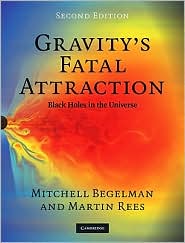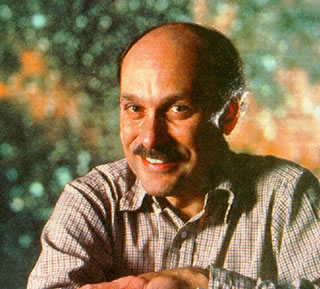About the topic
Bio
Get the Flyer
About the topic
Black holes are common objects in the universe. Each galaxy contains large numbers—perhaps millions—of stellar-mass black holes, each the remnant of a massive star. In addition, nearly every galaxy contains a supermassive black hole at its center, with a mass ranging from millions to billions of solar masses.

Black holes are places where gravity is so strong that nothing that enters them—not even light—can escape. Within a finite region surrounding the center of a black hole, all light rays and physically realizable trajectories of particles are directed inward. Space and time are so distorted that there is literally no way out.
In many cases we can observe radiation emitted by gas located just outside the horizon, or jets of plasma flowing outward from the region around the horizon, at close to the speed of light. Gamma-rays, first detected from jets more than a decade ago, provide crucial evidence that particles are being accelerated to very high energies.
In the giant elliptical galaxy M87, 50 million light-years away, radio observations have traced such jets down to the immediate surroundings of the black hole, to less than 100 event horizon radii away from the surface (event horizon) of the black hole. M87's jets are thought to form just outside the region where a swirling disk of gas makes its final plunge into the black hole. A major objective of black hole research is to use such observations to map the structure of spacetime near the horizon, thus testing whether these objects have exactly the properties predicted by general relativity. For example, we are well on our way toward being able to measure the tornado-like twisting of spacetime attributable to a black hole's spin.
The energy liberated by matter as it is heated by friction close to the horizon of the spinning black hole is prodigious and can markedly affect a black hole's surroundings. Large black holes at the centers of galaxies have been implicated in the energy balance of gas thousands of light years away, and they may play a crucial role in the galaxy formation process. The collapse of massive stellar cores to form stellar-mass black holes could be responsible for triggering certain types of gamma-ray bursts, the most luminous phenomenon known. Thus, black holes are not only astonishing physical entities in their own right, as well as laboratories for the most extreme conditions encountered in the post–big bang universe; they are also key players in phenomena with which we have long been familiar. To understand stars, galaxies, and the gas that lies between them, we must understand how black holes form, where they form, and how they affect their environments.
Questions regarding the source of power for the jets can be addressed: Is it the energy contained in the swirling gas about to be swallowed, or is it rotational energy stored in the black hole itself? We also do not know whether the jets are made of ordinary plasma consisting of protons and electrons, or of an exotic mix of electrons and positrons. And the importance of magnetic fields in jet dynamics and energetics, though strongly suspected, has yet to be proven. Gamma-ray astronomy will likely play a key role in resolving these questions, not only via the ground-based TeV arrays but also through the Fermi Gamma-Ray Space Telescope, launched in 2008 and already releasing data of unprecedented quality.
Physicists will continue to study the interiors of black holes intensively (and theoretically) for clues to the fundamental structure of matter, the quantum nature of spacetime, and the possible existence of extra dimensions. For the public, black holes will retain their metaphorical implications of disappearance and mystery. Astrophysicists, on the other hand, have recently appreciated how commonplace black holes are. As we learn more about their formation and how they interact with their environments, we will understand their roles in shaping the formation and evolution of the galaxies we see around us.
A fun animated site explaining black holes from the Space Telescope Science Institute.
Ted Bunn at Berkeley explains black holes and related stuff, including what to do if you fall into one, in a friendly chatty FAQ that was written a while ago but is mostly still valid (much better observation systems are available now.)
Bio
 Mitch Begelman is a Professor in the Department of Astrophysical and Planetary Sciences, as well as a Fellow of JILA (which used to stand for Joint Institute for Laboratory Astrophysics, the way IBM used to stand for International Business Machines), both at the University of Colorado, Boulder.
Mitch Begelman is a Professor in the Department of Astrophysical and Planetary Sciences, as well as a Fellow of JILA (which used to stand for Joint Institute for Laboratory Astrophysics, the way IBM used to stand for International Business Machines), both at the University of Colorado, Boulder.
Mitchell Craig Begelman was born in New York and graduated from Bronx High School of Science before attending Harvard, where he was a National Merit Scholar and Phi Beta Kappa, to obtain A.B. and A.M. degrees in physics. He then went to the University of Cambridge to study with Martin Rees for his Ph.D. in theoretical astrophysics; his thesis was entitled Aspects of Accretion Theory (the physics of accretion of stuff onto black holes and compact stars). At Cambridge he was a National Science Foundation graduate fellow, and was awarded the Isaac Newton Studentship, named for a fellow Cambridge alumnus. He arrived at the University of Colorado Boulder in the early 80s , moving up the ranks to Professor and serving twice (and currently) as chair of the Department of Astrophysical and Planetary Sciences. He is also a Fellow of JILA. He has received too many honors and awards to list any others. He serves as Vice-Chair of the National Academy of Sciences Astro2010 "Galaxies Across Cosmic Time" panel.
Mitchell Begelman and Martin Rees, Gravity’s Fatal Attraction: Black Holes in the Universe (W. H.
Freeman: Scientific American Library Series No. 58, New York, 1996), 246 pp.
Winner of the 1996 American Institute of Physics Science Writing Award.
Named one of the Outstanding Academic Books of 1996 by Choice Magazine.
Reviewing this book, Stephen W. Hawking wrote: 'Martin Rees and Mitchell Begelman are probably the world's leading authorities in the astrophysics of black holes.'
Mitchell Begelman, Turn Right at Orion: Travels Through the Cosmos
A (highly educational) novel. Available at Amazon.com. From the book:
Is there a better place to experience pure gravity than in the vicinity of a black hole? After all, a black hole is often described as the disembodied gravitational field that is left behind when matter is sucked out of this universe and goes…who knows where?
